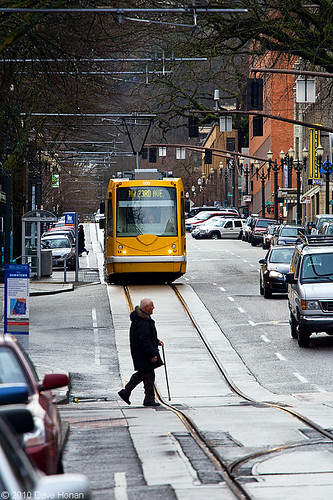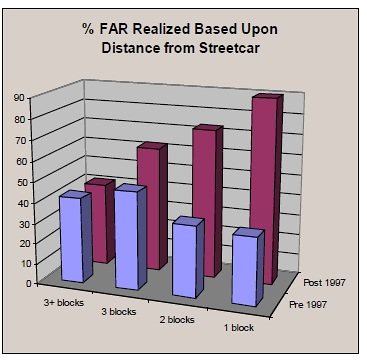Portland streetcar development report and a point about transit and development potential and realization

New Year's on 10th Avenue - Portland, Oregon. Flickr photo by Dave Honan.
Related to the entry from yesterday, about a crosstown streetcar line in DC and how it would enable and likely accelerate the development of various significantly large projects, there is a brief in the California Planning and Development Report on streetcars, "California Cities Desire Streetcars."
From the article:
Each of these cities can look to San Francisco for inspiration. There, vintage streetcars have been running along Market Street and throughout the city continuously for over a century.
Unlike light rail lines, which dominated rail transit over the past two decades, streetcars travel at grade and usually in the flow of traffic, without dedicated rights of way. It is their integral role in the streetscape that, supporters say, make them sought-after tools for urban development and economic development.
“They can catalyze development because of their real and perceived sense of permanence,” said Zach Seal, Broadway Streetcar Project manager for the City of Oakland. “Once the developers see the tracks laid in the asphalt they know the streetcar will be there for decades and know they can make large investments in dense, green, mixed use housing along the streetcar line.”
Long Beach City Councilmember Suja Lowenthal views her city’s pursuit of a streetcar as a way to appeal to new transit riders who are attracted to fixed rail: “streetcars serve a different customer than buses, attracting more choice riders and tourists/visitors who are willing to travel on a rail system in an unfamiliar city.”
By that same token, however, streetcars’ most often-cited downside is that by traveling in the flow of traffic they cannot move any faster than the average bus or car. Moreover, transit planner and streetcar critic Jarrett Walker notes in a recent blog post, “Streetcars: An Inconvenient Truth,” that for the cost of a streetcar system local businesses, property owners, and redevelopment agencies could invest in pavement upgrades, street furniture, and myriad other amenities that would enhance pedestrian life.
Moreover, streetcar systems do not tend to serve regional goals.
The interesting point about Jarrett Walker's post (and normally he is absolutely great) is that he misses the point about streetcars (1) driving increases in use of transit on the part of choice riders and (2) driving significant levels of positive real estate development. Plus, he says that streetcars that replace bus lines aren't a mobility improvement, when clearly that isn't the case in terms of the increased capacity and the improved quality of the ride.
And the point about "regional goals" is almost irrelevant as it misses the point that streetcar projects for the most part are about rebalancing development within a metropolitan area back on the center city, to reduce the rate of suburban sprawl and exurban development. It's about repositioning and strengthening the center city.
The CPDR mentions a report from Portland, PORTLAND STREETCAR DEVELOPMENT ORIENTED TRANSIT, but doesn't include a link. The report is pretty simple, but has some amazing information:
Since 1997 when the original streetcar alignment was identified, properties along its length have experienced significant changes:
• 55% of all CBD development since 1997 has occurred within 1-block of the streetcar and properties located closest to the streetcar line more closely approach the zoned density potential than properties situated farther away.
That's from the summary. Given the recent discussion about Walmart stores in DC being somehow transformative because they are "more urban" which is definitely true in one case and not at all in the other three, this point is incredibly important:
• 55% of all CBD development since 1997 has occurred within 1-block of the streetcar and properties located closest to the streetcar line more closely approach the zoned density potential than properties situated farther away.
The report goes further:
Prior to 1997, new projects were built to less than half of the allowable density allowed on a site in the CBD. Since the streetcar alignment was chosen in 1997, new development achieved an average of 90% of the FAR potential within one block of the streetcar line. This percentage steadily drops to 43% at three or more blocks from the alignment. Source: ED Hovee & Company, Portland Streetcar Development Impacts, October 2005.

That's huge. That's exactly the issue with a lot of projects in parts of the city, including the proposed Walmart at Georgia and Missouri Avenues NW -- the single use, one maybe two story discount store will use only a portion of the allowable development capacity of the parcel, thereby reducing the opportunity of this development to further contribute to revitalization objectives for the corridor.
Labels: real estate development, sustainable land use and resource planning, transit and economic development, transportation planning



0 Comments:
Post a Comment
<< Home